Whether you have lived in Jersey City for a minute or a decade you can’t miss the mammoth mural spanning several buildings on Christopher Columbus Drive from Grove to Barrow Streets. Though it’s a bit of a faded vision now, once upon a time it was a sight to behold. The mural was not only unprecedented for Jersey City in 1997, but for a period of time it laid claim to the title “largest mural in the U.S.” For those of you Jersey City old-timers who are saddened to see the our most famous landmark wall be painted over, here is the backstory — a tale of uncanny coincidence and an amicable passing of the torch.
Special guest blogger Jayne Freeman (aka: Street art photographer, JanyeWest) chats with Franc Palaia, co-founder of Pro Arts and original muralist on The Columbus Drive mural.
JF: First, I have to ask how is it that you, one of the original muralists behind this wall, are standing here helping Gaia paint OVER that same wall?
FP: I went to Kingston NY, near where I live, to see the O+ festival where there was a lot of art and music going on – a wellness festival to benefit artists. I asked this nice couple in a cafe for a map, we started talking and they introduced me to their son, Gaia, who happened to be the curator for the festival murals. Somehow in the conversation “Jersey City” came up and Gaia said he was doing a mural there next week. It didn’t take us long to figure out that he was doing a mural OVER our 1997 mural.
JF: How did this make you feel initially?
FP: I was kind of surprised at first, but I knew the wall was looking pretty worse for wear. Not just the graffiti, but it gets a lot of sun, so it’s faded – plus some of the original buildings were torn down…there were windows and changes made to the facades – a lot had changed. Even my original Dixon Mills pencil is long gone.
JF: So, this was a crazy coincidence, original and new artists meeting randomly miles away from Jersey City. One might argue it was “meant to be.”
FP: Yeah, we all thought so. So, instead of feeling bitter about it I just asked if I could come and help with the wall, since I was going to be here for my show. And Gaia was happy to have the assistance.
JF: Where’s your show?
FP: At Casa Colombo [The Italian Education & Cultural Center] on Monmouth Street. It’s mixed media, photographs, light boxes, illuminated photo-sculpture – all part of a series I’ve done on Roman aqueducts.
JF: Sounds beautiful – I’ll make a point of seeing it! Okay, so tell me – Jersey City in 1997 was a very different place. How did you manage to procure such a huge wall for this epic mural project?
FP: It wasn’t easy! A bunch of us artists in the early 90s were trying to get some walls to paint around the city. But asking for these walls as individuals had no effect. We were like a few gnats in the ears of politicians that just got swatted away. Then a councilperson, whose name I can’t even remember, suggested that we band together and create some kind of organization. That is one way of getting politicians attention; you create more traction as a group, than as one person.
JF: So that was the genesis of Pro Arts?
FP: Yes. I am the co-founder of Pro Arts which dates back to the early 90s. We were the ones who started the Studio Art Tour in 1989 before we were even recognized as an arts organization.
JF: Did the creation of Pro Arts help you procure the wall?
FP: It helped – but we needed tons of other support too. The city agreed, but we had to fund it ourselves basically. It took a combination of federal, state, county, and city funding, plus grants, private donations, corporate donations, endless bureaucracy and a lot of pounding the pavement to get it done. One of the original Pro Arts members, photographer Leon Yost, worked as the liaison between us artists and the city. He helped move the project forward and sort through the permits and bureaucracy. Eventually we came up with the quarter million dollars it took for the job.
JF: A quarter million dollars?!
FP: Yes! Which today would be an even huger number, if you think about it. We had to buy paint, get lifts & “cherry-pickers”, pay the artists – it was a huge ordeal. The original crew was
Rupert Ravens, Caroline Burton, Barbara Stork, Greg Brickey, and me of course, working as the co-project manager [with Rupert] as well as a painter, coordinator and referee for the endless fights that broke out – no joke! We also had several Rutgers art students helping us out. Almost 20 people can be credited with painting that wall and it took six months to prep and finish the wall — but we came in under budget!
JF: Did you realize at the time that this would be “the largest mural on the east coast?” [Eventually it was no longer the largest in the U.S. but still the largest on the east coast.]
FP: No, not at all! We just chose it because it was a huge expanse of what we saw as “dead wall” — no action, backs of stores, no windows, no awnings – just a giant urban canvas. It took a while to settle on a design, but it was my idea to combine everyone’s ideas into a collage and Rupert created the final design which includes Jersey City and New York City landmarks. It’s even been in a few movies and TV shows, like “Mercy Hospital” filmed in Jersey City. In the movie “Bad Company” with Chris Rock they use the wall so much in the storyline that it’s practically a character!
JF: Did the character get paid as an extra?
FP: Nah…but it should have!
JF: So bringing us to present – here you are helping Gaia, a young and talented muralist, go over the work you guys toiled to bring to life. Is that bittersweet?
FP: The wall has seen its day. It’s time to pass the torch to a new group of artists and get some fresh paint up there. Just like downtown Jersey City is changing every day – it was time this wall caught up with the present.
JF: Excellent attitude – it’s been a pleasure hearing your story….

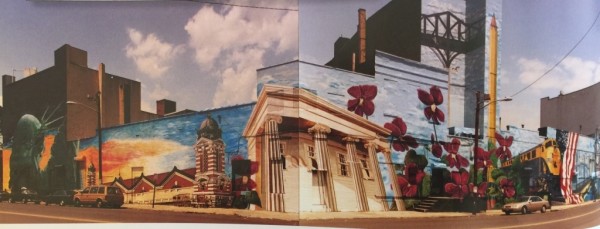
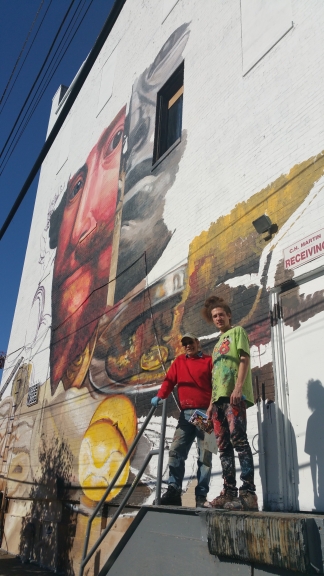
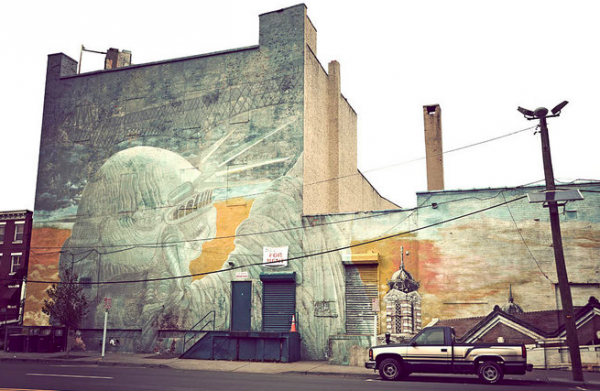
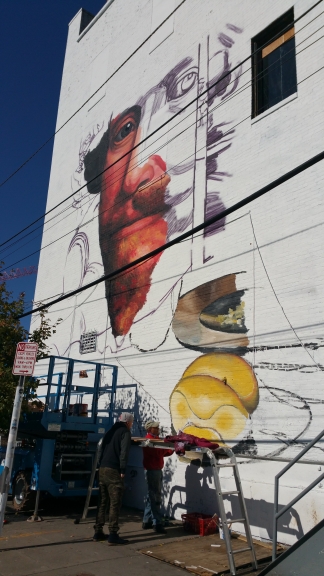
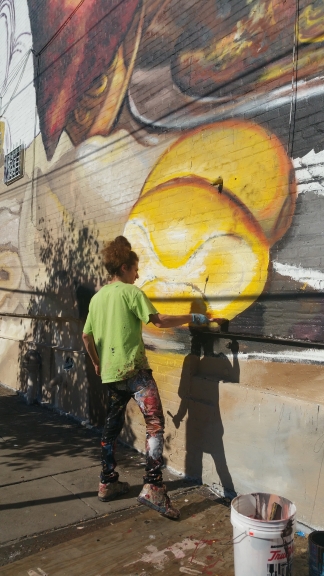
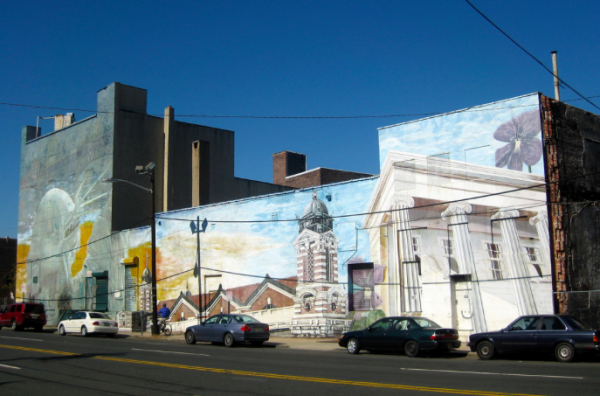

Great interview Jayne. Franc is an unsung hero. He did the first organization banner fir the Friends of LSP